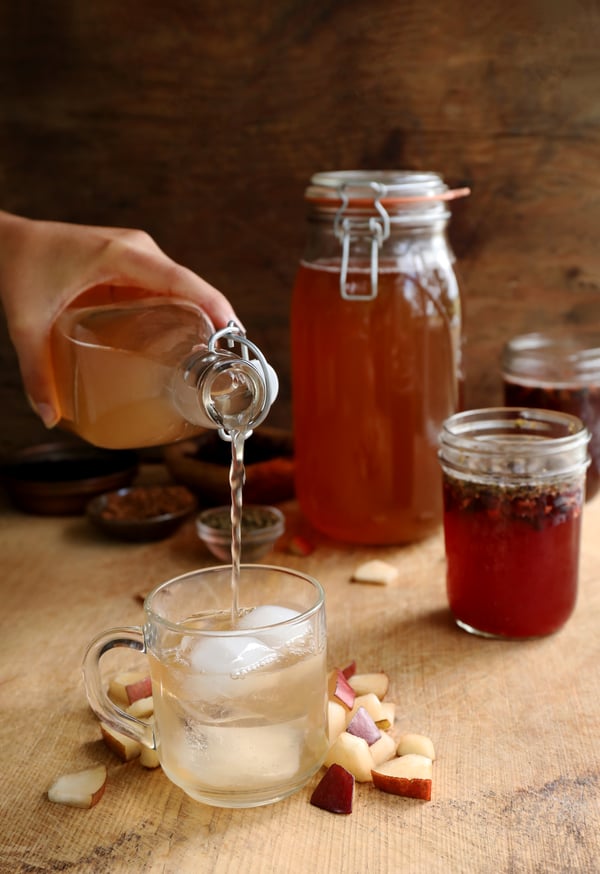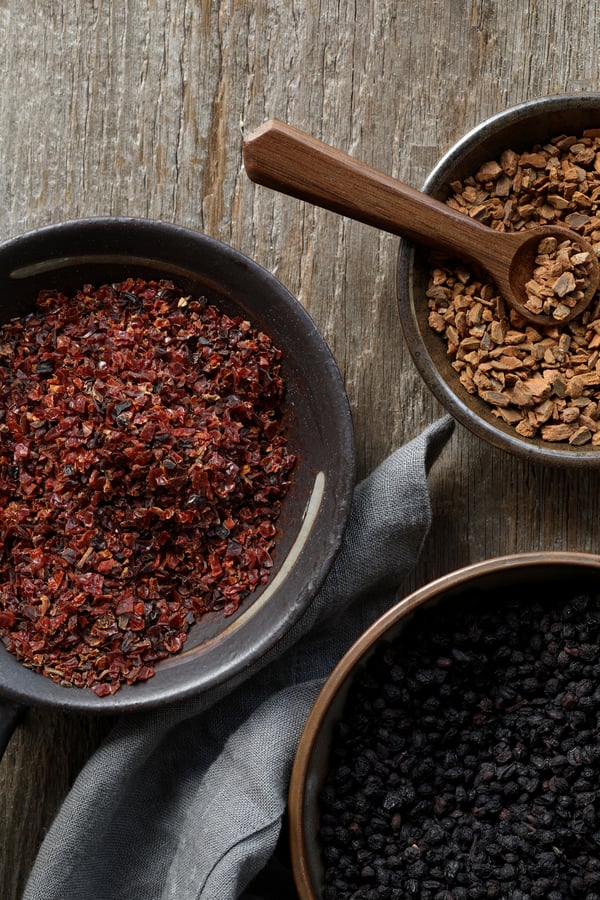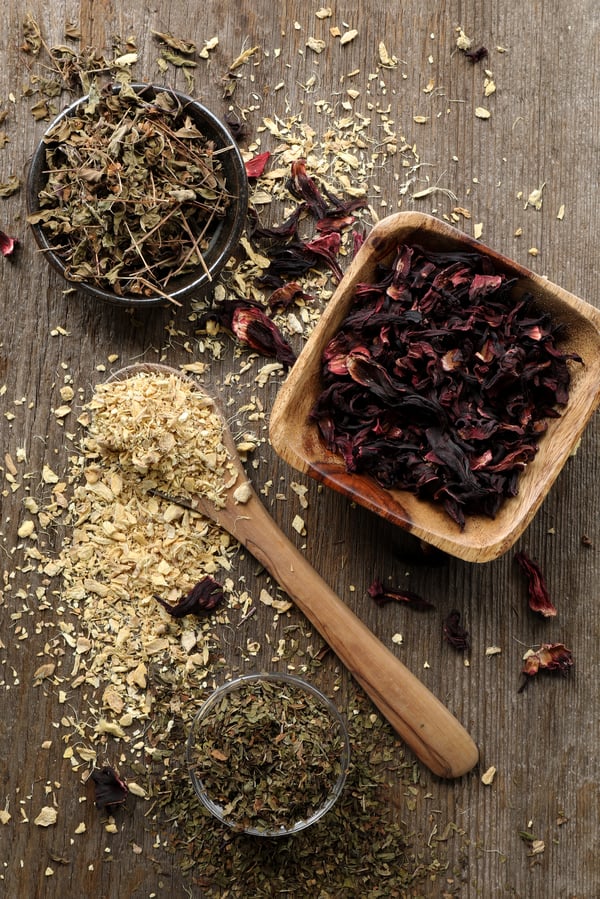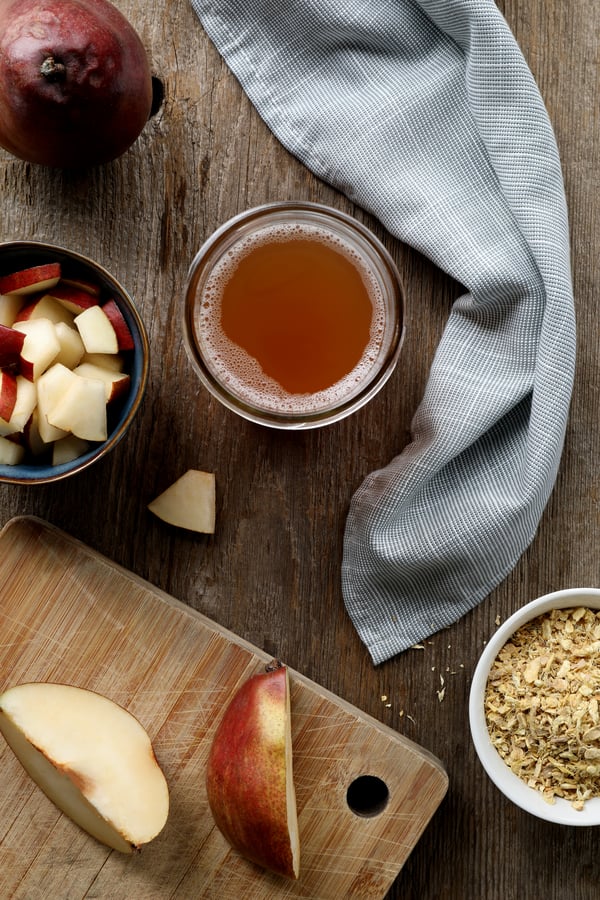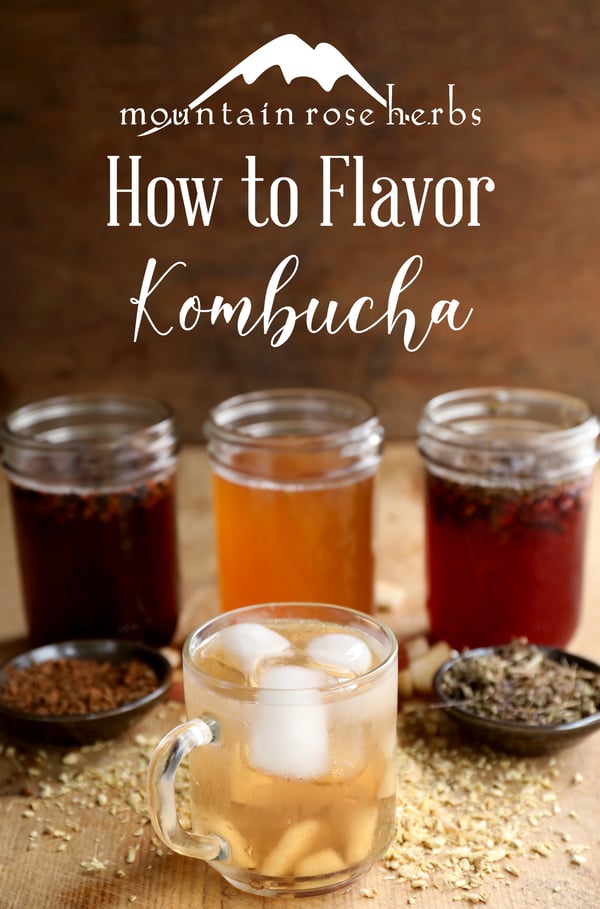If you’ve ever endeavored to brew your own kombucha, you know that the SCOBY-covered result of your initial ferment has a rather plain flavor when compared with your favorite professionally made varieties—but it doesn’t have to stay that way! The combinations of herbs, spices, fruits, and juices that can add flavor to your homemade kombucha are almost endless, allowing you to transform your original tangy tea canvas into countless quaffable masterpieces.
How to Flavor Kombucha: The Basics
- Make a batch of plain, fermented kombucha tea.
- Transfer SCOBY and 1 to 2 cups plain kombucha into a clean glass container with lid and store this in fridge for future ferments.
- Add flavoring ingredients of choice to remaining plain kombucha.
- Secure lid and let ingredients infuse at room temperature for 1 to 2 days.
- Taste infused kombucha for flavor. If needed, add more ingredients to adjust flavor balance or let steep another 2 days to increase flavor intensity.
- When desired flavor is reached, strain out flavoring ingredients and transfer kombucha into glass bottles with secure stoppers.
- To build carbonation, let sealed bottles sit on counter top at room temperature for 2 to 3 days.
- Store finished kombucha in refrigerator and consume within about 2 weeks.
Kombucha Flavoring FAQs
When do I add flavoring to my kombucha?
I’m often asked at what point in the kombucha making process should flavors be added. While thoughts on this subject vary somewhat by personal method and the ingredients used, in general, I like to allow my kombucha to fully ferment before adding my favorite flavor combinations (as noted in our earlier post on kombucha making, plain kombucha usually takes one to two weeks to develop).
The reason for adding flavoring after fermentation is that some botanicals can interfere with the fermentation process, and even if they don’t, they can add distinctive flavors to your starter tea that will come through in future batches, which can somewhat limit your flavoring options.
Do I leave the SCOBY in my kombucha when flavoring?
Since some flavoring ingredients will affect the health and/or flavor of your SCOBY, you’ll likely want to remove most of it before adding herbs, spices, or other ingredients.
After your brew has reached your desired level of tanginess, remove the SCOBY and one to two cups of liquid to reserve as “starter tea” for your next batch. At this point, you can store the SCOBY in the starter tea in an airtight glass jar in the fridge and store for up to several months until you are ready to start your next batch of ‘bucha.
After I add my flavors, how long do I have to wait before my kombucha is ready?
I let my ingredients steep in the kombucha in a large, clean glass jar with a lid at room temperature for one to two days, to start. This is usually plenty of time for your flavors to infuse, and you can taste the liquid after this time frame to see if a longer steep or more ingredients are needed.
When you’re happy with your kombucha’s flavor, I recommend straining out your added ingredients before drinking. Use a funnel with filter and/or some cheesecloth. Otherwise, you'll likely end up with bits of plant material stuck in your teeth!
Can fresh ingredients be used to flavor kombucha in place of dry? If so, do they need to be specially prepared?
My years of working at Mountain Rose Herbs have built up my spice cabinet to near bursting, so I tend to gravitate towards dried ingredients for my kombucha flavorings. However, fresh ingredients can definitely be used and are a fun way to infuse seasonal flavors into your ‘buch rotation.
In general, no special preparation is required for adding fresh herbs and other plant material to your kombucha. Keep in mind that, just like with making a tincture or tea, ingredients infuse more quickly and completely when you expose more surface area, so you may wish to roughly chop roots or lightly mash berries to help unlock their flavors. I avoid using powders, as they tend not to strain out well and leave an undesirable grittiness behind in the final beverage.
DO make sure you are using clean plant material grown without toxic pesticides/herbicides (this is particularly important to keep in mind when wildharvesting ingredients).
Will flavoring affect the shelf life of my kombucha?
If properly stored in an airtight glass container in the refrigerator, most flavored kombuchas will last about as long as plain kombuchas. However, if you are using very perishable ingredients like fresh fruit, you may find that your kombucha will spoil more quickly, so you’ll want to be sure to keep these batches refrigerated and consume within a week.
How do I make my kombucha fizzy after flavoring?
In order to increase carbonation, I transfer my kombucha into individual glass bottles with secure lids, then leave the bottles on a counter top for 2 to 3 days to ferment/carbonate before popping them into the fridge. Some folks find that adding a bit more sweetener or sweet, fresh fruit before this counter top ferment can encourage more natural fermentation, but I have not personally had much success with this method.
Homemade Kombucha Flavor Ideas
Here are some of my favorite blends, but feel free to be creative and experiment with your own favorite flavors! Each blend is intended to flavor one gallon of plain, pre-fermented kombucha.
Elderberry, Cinnamon & Rosehip Kombucha
A standby, this is the blend that I make most often. Sometimes, I’ll add hibiscus flowers or use ginger root instead of cinnamon. Feel free to experiment and make this recipe your own!
- 1 gallon plain kombucha
- 1/3 cup organic dried elderberries
- 1/4 cup organic dried rosehips
- 1 tsp organic cinnamon chips
Sparkling Ginger Pear Kombucha
This recipe is simple, yet delicious. It is light, refreshing, and reminiscent of champagne. Use whichever fruit is in season: raspberries, blueberries, blackberries, apricots, and peaches are all tasty substitutes for pears.
- 1 gallon plain kombucha
- 1 Asian or regular pear
- 1 Tbsp. dried organic ginger root
Refreshing Floral Spice & Tulsi Kombucha
A perfect blend for the summertime! This medley is cooling, refreshing, and the addition of Yerba Mate offers a little energy boost.
- 1 gallon plain kombucha
- 1/2 cup organic dried hibiscus flowers
- 2 Tbsp. dried organic holy basil (Tulsi)
- 2 Tbsp. dried organic peppermint
- 1 Tbsp. dried organic ginger root
- 1 Tbsp. dried organic Yerba Mate
READY TO GET Back to ‘Bucha Basics?
Learn How to Make Your Own Kombucha!
You may also enjoy:

